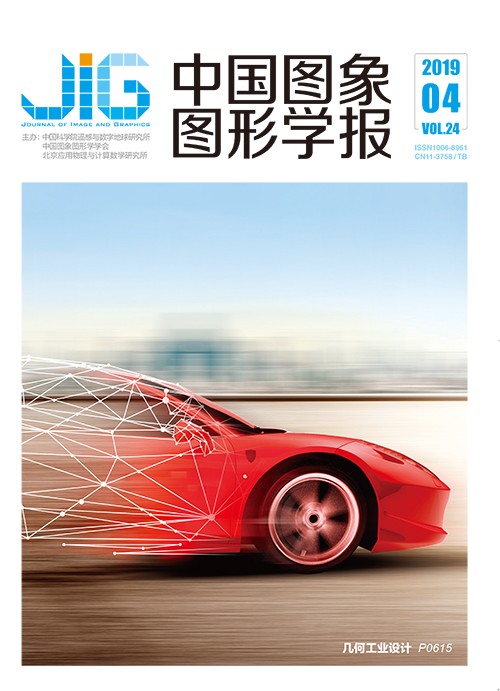
基于熵加权K-means全局信息聚类的高光谱图像分类
摘 要
目的 高光谱图像波段数目巨大,导致在解译及分类过程中出现“维数灾难”的现象。针对该问题,在K-means聚类算法基础上,考虑各个波段对不同聚类的重要程度,同时顾及类间信息,提出一种基于熵加权K-means全局信息聚类的高光谱图像分类算法。方法 首先,引入波段权重,用来刻画各个波段对不同聚类的重要程度,并定义熵信息测度表达该权重。其次,为避免局部最优聚类,引入类间距离测度实现全局最优聚类。最后,将上述两类测度引入K-means聚类目标函数,通过最小化目标函数得到最优分类结果。结果 为了验证提出的高光谱图像分类方法的有效性,对Salinas高光谱图像和Pavia University高光谱图像标准图中的地物类别根据其光谱反射率差异程度进行合并,将合并后的标准图作为新的标准分类图。分别采用本文算法和传统K-means算法对Salinas高光谱图像和Pavia University高光谱图像进行实验,并定性、定量地评价和分析了实验结果。对于图像中合并后的地物类别,光谱反射率差异程度大,从视觉上看,本文算法较传统K-means算法有更好的分类结果;从分类精度看,本文算法的总精度分别为92.20%和82.96%, K-means算法的总精度分别为83.39%和67.06%,较K-means算法增长8.81%和15.9%。结论 提出一种基于熵加权K-means全局信息聚类的高光谱图像分类算法,实验结果表明,本文算法对高光谱图像中具有不同光谱反射率差异程度的各类地物目标均能取得很好的分类结果。
关键词
Hyperspectral image classification algorithm based on entropy weighted K-means with global information
Li Yu, Zhen Chang, Shi Xue, Zhao Quanhua(Institute for Remote Sensing, School of Geomatics, Liaoning Technology University, Fuxin 123000, China) Abstract
Objective Hyperspectral remote sensing has become a promising research field and is applied to various aspects. Thus, hyperspectral image classification has become the key part of hyperspectral image processing. The important trait of hyperspectral images is the excessive number of bands, which results in the phenomenon of "the curse of the dimension" in their interpretation and classification. Utilizing this band information fully in the classification of hyperspectral images is difficult. K-means algorithm is the most classical clustering algorithm, which is widely used for image classification. The general idea of K-means algorithm is to treat every feature as equally important. However, when the K-means algorithm is used for the classification of hyperspectral images, every band is regarded as a feature, which leads to the difficulty in feature utilization and poor classification results. To solve this problem, the idea of feature weighting is introduced. Therefore, this study proposes a hyperspectral image classification algorithm based on entropy weighted K-means by considering global information. Method The proposed hyperspectral image classification method is based on the K-means clustering algorithm and considers them to indicate the importance of every band to different clusters and the inter-cluster information. Feature weighting is used to distinguish the importance of every band to different clusters, as described by the band weight. In statistics, entropy represents the degree of uncertainty of information. Thus, entropy information measurement is defined to express the weight distribution. In hyperspectral image classification, the distance between classes greatly influences the clustering results. The distance measurement of inter-cluster information is introduced to realize the global optimal clustering to avoid the local optimal clustering and obtain more accurate results. These two types of measurements are introduced into the K-means clustering objective function, and the optimal classification results are obtained by minimizing the objective function. Result Classification experiments are conducted using the proposed algorithm and K-means algorithm on Salinas and Pavia University hyperspectral images, respectively, to verify the proposed hyperspectral image classification method effectively. The ground objects in the standard images of Salinas and Pavia University are merged on the basis of the difference in the degree of spectral reflectance, and the combined standard images are considered the standard classification information. The classification results demonstrate that the proposed algorithm can effectively obtain better results than K-means algorithm. The overall accuracy and Kappa coefficient are calculated from a confusion matrix and compared with K-means algorithm to evaluate the proposed algorithm quantitatively. The overall accuracy of the algorithm is 92.20% and 82.96%, indicating 8.81% and 15.9% improvement compared with the K-means algorithm. The accuracy values demonstrate that the proposed algorithm can achieve more precise classification results than K-means algorithm. Conclusion This study proposes a hyperspectral image classification method that connects the traditional K-means algorithm with the idea of feature weighting and the inter-cluster information. Experimental results show that this approach is promising and effective and can achieve excellent classification results for all types of ground objects in hyperspectral images with large spectral reflectance differences. In future research, the similarity between features and the spatial information must be improved.
Keywords
feature weighting entropy information inter-cluster information K-means hyperspectral image classification
|



 中国图象图形学报 │ 京ICP备05080539号-4 │ 本系统由
中国图象图形学报 │ 京ICP备05080539号-4 │ 本系统由